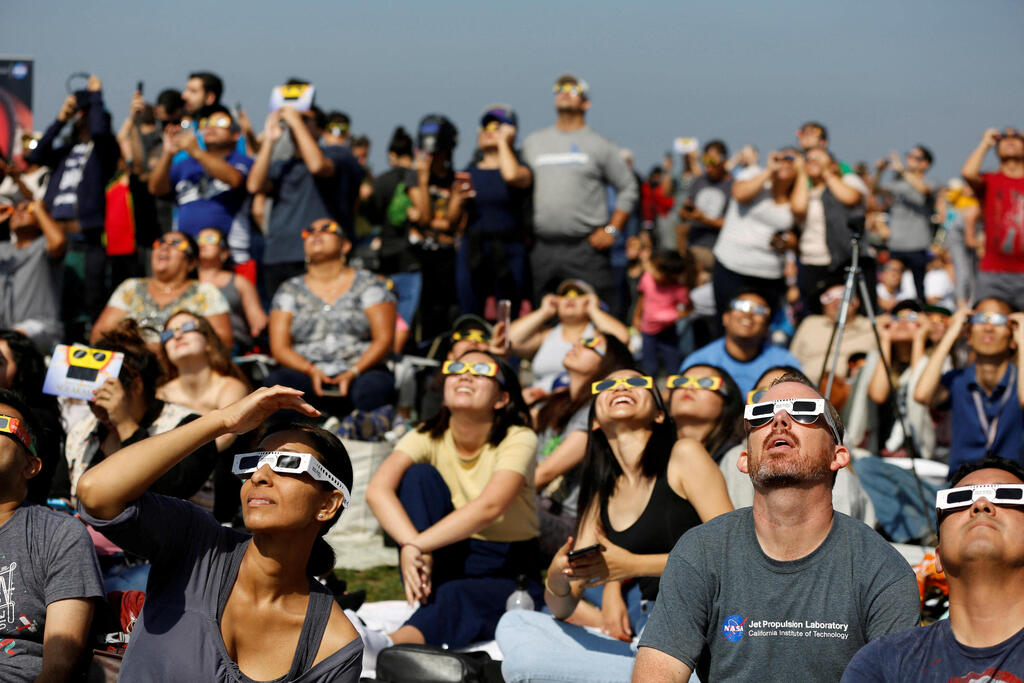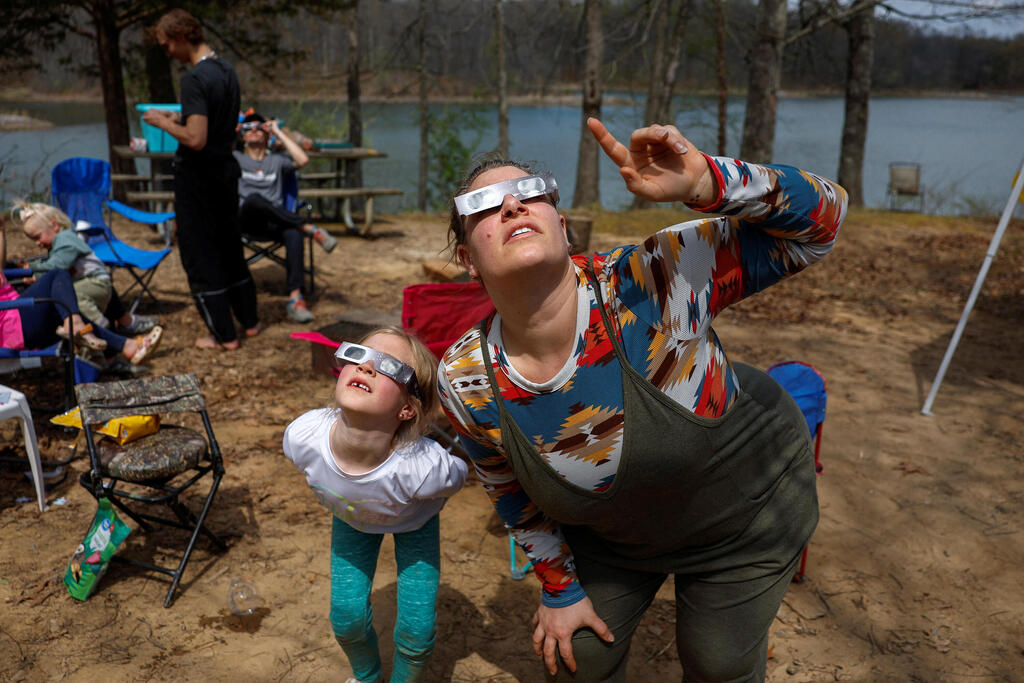Getting your Trinity Audio player ready...
The moon will blot out the sun for millions of people in North America along a path crossing from Mexico into the United States and then Canada in a total solar eclipse occurring on Monday, April 8.
Here is everything you need to know:
What is a total solar eclipse?
In a total solar eclipse, the moon passes between the sun and Earth, entirely covering the face of the sun along a small path of our planet's surface. This is called the "path of totality." The daytime sky turns dark, akin to dusk or dawn, and nocturnal animals have been known to wake up, confused into believing night has arrived.
2 View gallery


People watch the solar eclipse on the lawn of Griffith Observatory in Los Angeles, California, U.S., August 21, 2017
(REUTERS/Mario Anzuoni/File Photo)
In places along the path of totality, people will be able to view the sun's corona – the star's outer atmosphere – that typically is not visible because of solar brightness. People observing from outside the path of totality will see a partial eclipse in which the moon obscures most of the sun's face but not all of it.
Of course, a cloudy day could spoil the view. After this one, the next total solar eclipse viewable from the contiguous United States will not occur until 2044.
Where will it be visible?
According to NASA, the April 8 eclipse will begin over the South Pacific, with its path reaching Mexico's Pacific coast at around 11:07 a.m. Pacific Time before entering the United States in Texas.
Its path then takes it through Oklahoma, Arkansas, Missouri, a tiny piece of Tennessee, Illinois, Kentucky, Indiana, Ohio, a tiny piece of Michigan, Pennsylvania, New York, Vermont, New Hampshire and Maine.
The path then enters Canada in Ontario and journeys through Quebec, New Brunswick, Prince Edward Island and Cape Breton, exiting continental North America on the Atlantic coast of Newfoundland, Canada, at 5:16 p.m. Newfoundland Time. A partial eclipse is due to be visible for people in all 48 contiguous U.S. states.
2 View gallery


Brittany Sunderman and Gianna Debenham, 6, and other members of the Debenham family who travelled from Utah and Las Vegas to experience the total solar eclipse together, try out their eclipse viewing glasses at their campsite a day ahead of the event at Camp Carew in Makanda, Illinois
(Photo: REUTERS/Evelyn Hockstein)
Where are some of the best places to see the eclipse?
Some major cities and their metropolitan areas lay within or near the path of totality. Some of these include: Mazatlan and Torreon in Mexico; San Antonio, Austin, Waco, Fort Worth and Dallas in Texas; Little Rock in Arkansas; St. Louis in Missouri; Louisville in Kentucky; Indianapolis in Indiana; Dayton, Columbus, Toledo and Cleveland in Ohio; Detroit in Michigan; Erie in Pennsylvania; Buffalo, Rochester and Syracuse in New York; and Hamilton, Toronto and Montreal in Canada.
How wide is the path of totality?
On Aug. 21, 2017, millions of people witnessed a total solar eclipse whose path crossed the contiguous United States. The path of totality for the April 8 eclipse will be wider than the one in 2017 because the moon was a little bit farther from Earth during that one. According to NASA, the path in 2017 ranged from about 62-71 miles (100-114 km) wide, while this one will range from about 108-122 miles (174-196 km) wide, meaning it will cover more ground. This year's eclipse path also is set to pass over more densely populated areas than the one in 2017.
What can you expect to see during the eclipse?
A total solar eclipse unfolds in several distinct stages. It starts with a partial eclipse phase as the moon begins to pass between Earth and the sun, partially blocking it and leaving the sun looking like it has a crescent shape.
In the subsequent Baily's Beads phase, points of light from the sunshine around the moon's edges because of the irregular lunar topography produce small beads of light.
In the diamond ring phase, a single bright spot appears along the lunar edge even as the sun's atmosphere leaves a ring of light around the moon. The effect resembles the appearance of a diamond ring. This phenomenon precedes totality. After totality, the other phases repeat as the moon keeps moving along its path until the eclipse ends.
How does this differ from an annular solar eclipse?
On Oct. 14, 2023, people along a path stretching from the U.S. Pacific Northwest, through Mexico, Central America, Colombia and Brazil witnessed an annular solar eclipse, a slightly different event. An annular solar eclipse occurs when the moon passes between the sun and Earth when the moon is at or near its farthest point from our planet. Thus, it does not completely cover the face of the sun, leaving what looks like a "ring of fire" in the sky.
How do you safely watch an eclipse?
Experts warn that it is unsafe to look directly at the bright sun without using specialized eye protection designed for solar viewing. Viewing an eclipse through a camera lens, binoculars or telescope without making use of a special-purpose solar filter can cause severe eye injury, according to these experts.
They advise using safe solar viewing glasses or a safe handheld solar viewer, noting that regular sunglasses are not safe for viewing the sun. The only moment it is considered safe for people to remove eye protection during a total solar eclipse is the brief time when the moon completely blocks the sun's surface.
How big are the Earth, moon and sun?
The moon will cover the sun's face, as visible from Earth, only because the moon – in actuality much smaller than the sun – is so much closer to our planet. The moon's diameter is 2,159 miles (3,476 km), compared to the sun's diameter of about 865,000 miles (1.4 million km) and Earth's diameter of 7,918 miles (12,742 km).
How do solar eclipses differ from lunar eclipses?
Lunar eclipses occur when Earth is positioned between the moon and the sun and our planet's shadow is cast upon the lunar surface. This leaves the moon looking dim from Earth, sometimes with a reddish color. Lunar eclipses are visible from half of Earth, a much wider area than solar eclipses.
Future eclipses
People in various parts of the world will get to experience more eclipses in the coming months and years, according to NASA.
An annular solar eclipse will occur on Oct. 2 of this year, visible in South America, with a partial eclipse visible in South America, Antarctica, the Pacific Ocean, the Atlantic Ocean and North America.
A partial solar eclipse will occur on March 29, 2025, visible in Europe, Asia, Africa, North America, South America, the Atlantic Ocean and the Arctic Ocean.
A partial solar eclipse will occur on Sept. 21, 2025, visible in Australia, Antarctica, the Pacific Ocean and the Atlantic Ocean.
An annular solar eclipse will occur on Feb. 17, 2026, visible in Antarctica, with a partial eclipse visible in Antarctica, Africa, South America, the Pacific Ocean, the Atlantic Ocean and the Indian Ocean.
The next total solar eclipse will occur on Aug. 12, 2026, visible in Greenland, Iceland, Spain, Russia and a small portion of Portugal, with a partial eclipse visible in Europe, Africa, North America, the Atlantic Ocean, the Arctic Ocean and the Pacific Ocean.

